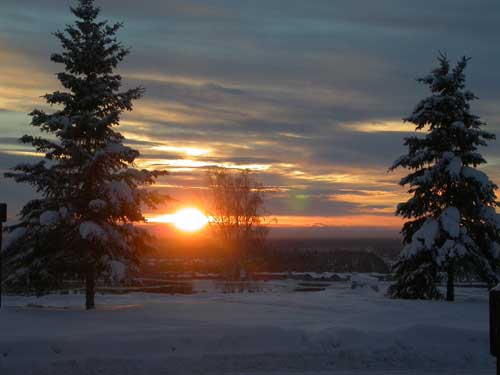 Is there a link between diabetes
and latitude?
Is there a link between diabetes
and latitude?
By NED ROZELL
July 08, 2008
Tuesday
Diabetes seems to afflict more northerners than those living
near the equator, making some researchers think exposure to sunlight
plays a role in the disease.
In a new study, scientists at the University of California, San
Diego found that cases of type I diabetes, in which the body
doesn't make enough insulin, increase with latitude. They recommended
children one and older who live about 30 degrees from the equator
receive supplemental vitamin D3 during the winter to reduce their
risk of childhood diabetes. The California researchers include
Sharif Mohr and Cedric Garland, and their study appeared in the
online version of the journal Diabetologia.
 Alaska's low sun angle
most of the year-here at the extreme in Fairbanks on winter solstice-means
our skin doesn't have much chance to convert sunlight to vitamin
D3.
Alaska's low sun angle
most of the year-here at the extreme in Fairbanks on winter solstice-means
our skin doesn't have much chance to convert sunlight to vitamin
D3.
Photo by Ned Rozell
"This is a very interesting finding," Abel Bult-Ito,
a professor of biology with the University of Alaska Fairbanks
Institute of Arctic Biology and Department of Biology and Wildlife,
wrote in an e-mail. "It does not surprise me that there
is a latitudinal trend in a lot of diseases, including diabetes.
The light-dark cycle is very important in synchronizing the circadian
or biological clock, and having that disturbed at high latitudes,
because of near constant light or near constant dark periods,
can increase the risk for disease, such as seasonal affective
disorder and sleep disorders."
Exposure of skin to sunlight is the source of up to 95 percent
of vitamin D that circulates within the body, according to Mohr
and Garland. Performing sort of like plants that convert sunlight
to sugars, our skin transforms strong sunlight to vitamin D3,
and it doesn't overdose, shedding the excess.
Those living in the tropics get sufficient doses every day of
the year, if they spend some time in direct sunlight. For about
half the year, the sun angle over Alaska is so low, we can't
get enough radiation for our skin to create vitamin D3.
"Homebound individuals, people living in northern latitudes
such as in New England and Alaska, women who wear robes and head
coverings for religious reasons, and individuals working in occupations
that prevent sun exposure are unlikely to obtain much vitamin
D from sunlight," wrote a researcher for the National Institutes
of Health.
The authors of the recent study said that children in mid-latitudes
should get five minutes of sun exposure at midday in summer and
about 10 minutes exposure in spring and fall to help jumpstart
the skin's production of vitamin D3. Northern children should
take 1,000-2,000 IU (international units) of vitamin D3 per day,
they recommended.
"That seems reasonable to me and brings their vitamin D
level up to those seen around the equator," Bult-Ito wrote.
Though diabetes is on the rise in Alaska Natives, they have relatively
low levels of the disease compared to American Indians in the
southern and southwest U.S.
"Alaska Native peoples who eat a predominantly traditional
diet do not have vitamin D deficiencies, probably because of
dietary intake and their bodies may be able to retain vitamin
D more efficiently," Bult-Ito wrote. "That would be
additional evidence for the importance of vitamin D because Alaska
Native peoples used to have very low diabetes rates."
Bult-Ito takes vitamin D supplements and thinks all northerners
could benefit from additional vitamin D.
"I would say that one study to show a link between vitamin
D and diabetes is not enough to state that all infants and children
should take vitamin D supplements to decrease their risk for
diabetes," he wrote.
"However, vitamin D is
important for other reasons as well, such as bone and brain health,
and combined with the low sun exposure in Alaska, vitamin D supplementation
would be a good thing for us."
This column is provided
as a public service by the Geophysical
Institute,
University of Alaska Fairbanks, in cooperation with the UAF
research
community. Ned Rozell [nrozell@gi.alaska.edu]
is a science writer at the institute.
E-mail your news &
photos to editor@sitnews.us
Publish A Letter in SitNews Read Letters/Opinions
Contact the Editor
SitNews
©2008
Stories In The News
Ketchikan, Alaska
|

